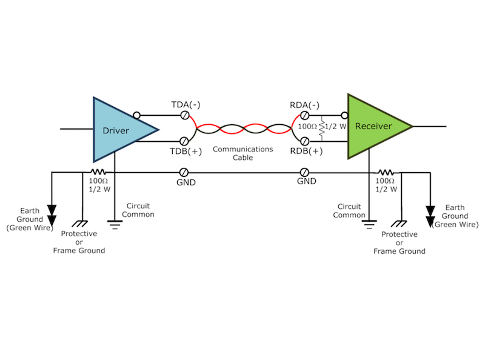Without proper grounding in a RS-422/485 installation, the user becomes vulnerable to common mode voltage transients that can compromise accurate data transfer and sensor measurements and damage equipment.

The terms "2-wire" and "4-wire" are often used when discussing RS-422/485 installations. These terms can be misleading because they suggest that there is no need for an additional ground wire. That isn’t the case. Without proper grounding, the user becomes vulnerable to common mode voltage transients that can compromise accurate data transfer and sensor measurements and damage equipment.
So although we talk about "2-wire" and "4-wire" installations, there will always be a need for an extra wire to connect the signal ground, which is often overlooked when ordering cable. Cable with a twisted pair and a third conductor does exist, as does cable with two twisted pairs and a fifth conductor. It’s easier to just use a cable with an extra twisted pair. The user can then use one or both conductors for the signal ground. A "2-wire" system, therefore, would require two twisted pairs; a "4-wire" system would require three.
RS-422/485 systems can sometimes communicate successfully without the signal ground. This can happen when the nodes are located in very close proximity and the local ground is at the same potential, as in a controlled lab environment. This method is not recommended because if any significant distance separates nodes—and there is no signal ground—lightning strikes and other electrical noise can cause the common mode voltage to rise to levels that can prohibit communications and result in serious damage.
Connecting signal grounds on both ends while keeping them separated from the earth ground is not sufficient to prevent issues in long RS-422/485 runs, even if you have a good physical earth connection and external surge protection. Sometimes users don’t connect the earth grounds at all, or they float one side and think that it offers some protection. Sometimes they don’t extend the signal ground, which eliminates the reference for the RS-485 signal. Either of these options may seem to work at first, but they’ll inevitably lead to intermittent communications issues and a greater potential for damaged equipment. Some refer to this kind of installation as "partially isolated," but it should really be called what it is: "Non-isolated."
When using isolation, the user should connect the signal ground between both ends. The isolated side should be kept on the long distance run. External surge protection is only required if large lightning-related surges to ground are expected. Exercise caution, however; surge suppressors on each end of the circuit might just provide a path for current to flow.
Don’t overlook power, either. If equipment is being powered on both ends of the circuit with the same power supply, this could very well provide a path around the isolation. If this is the case, a triple isolated product will be needed. Triple isolation extends isolation to each data port as well as the power supply, insuring a completely isolated system.
Brian Foster, product manager, Advantech B+B SmartWorx. Edited by Chris Vavra, production editor, CFE Media, Control Engineering, [email protected].
Key Concepts
- An extra ground wire is needed for "2-wire" and "4-wire" RS-422/485 installations to protect data transfer and equipment from damage.
- The user should understand their environment and install based on their surroundings for maximum protection.
Consider this
What challenges have you encountered that weren’t mentioned in this article? How did you overcome them?
ONLINE extra
See related articles about RS-422/485 linked below.



